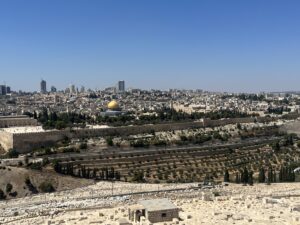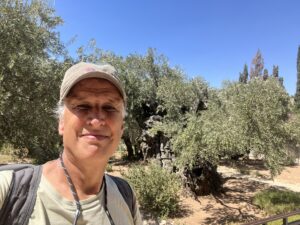This past week I’ve been in Israel, traveling around with my son Isaac. I arrived a day before he flew in, spending an enlightening 24 hours in the Old City of Jerusalem. There I witnessed power dynamics at play between Judaism and Islam, Israelis and Palestinians, and between Christians of different denominations. I was struck afresh that Jesus located himself outside the walls, disinterested in seizing power in any way.
On my first night just after flying in, I headed to David’s Tomb, which is located just below the Upper Room where Jesus celebrated his last Passover on the eve of his arrest. The area is called Mount Zion, though most consider the true Mount Zion to be in another place– and there’s also disagreement about the true location of the Upper Room.
When I arrived at the Upper Room there were many Orthodox Jews playing music and celebrating something there, outside David’s Tomb. I headed up an outside stairway to the Upper Room and found it locked. I then walked down the steep, ancient stone streets to the Western Wall (aka the Wailing Wall), where religious Jews were standing and praying before what’s considered the only remains of the Jerusalem Temple. Even at midnight there were thousands of Orthodox-looking Jews milling around, apparently gearing up for Rosh Hashanah, the beginning of the Jewish New Year and other feasts. Small bands of heavily-armed Israeli soldiers patrolled everywhere.
The next morning I returned to the Upper Room on a personal pilgrimage to retrace Jesus’ steps from the site of his Last Supper to Gethsemane, the Mount of Olives and eventually to the Via Dolorosa—a pilgrimage walk consisting of 15 stages, including Jesus’ crucifixion.
Things were calm when I started out, and I found myself easily able to get into a contemplative space that lasted most of the day.
In the Upper Room I sat atop a stairway and read the accounts in each of the Gospels and took communion, amidst crowds of pilgrims from many nations. A group from some Latin American country were praying in tongues in a circle below me.
I then walked down through the Kidron Valley to the Garden of Gethsemane, where I read the story of Jesus’ betrayal and arrest in each of the Gospels. I read these stories there in the garden, and as I was ascending the Mount of Olives I was struck afresh by Jesus’ outsider status.
Jesus is described in numerous Gospel accounts as teaching in the Temple and then retreating with his disciples to the Mount of Olives outside the city. From the Garden of Gethsemane Jerusalem’s walls and the Temple Mount, the site of the original Jerusalem Temple, tower ominously above.
From the top of the Mount of Olives I scanned the coveted burial grounds, where religious Jews seek to be buried facing Jerusalem’s Temple Mount, to be first in line when the Messiah returns and judges the dead. But there in the site of the Jewish temple stands one of Islam’s holiest mosques- the Dome of the Rock.
When Jesus is visiting Jerusalem from his base of operations in Galilee, he is often described as staying with his disciples on the Mount of Olives. From there he makes incursions into the Temple, where he teaches, often getting into confrontations with the religious authorities.
From the Mount of Olives hillside looking across at Jerusalem, Jesus and his disciples appear as outliers, and it’s not a stretch to see them as a sort of non-violent guerrilla band—challenging the established authorities with poignant teachings on the Kingdom of God, backed up by healings and acts of non-violent resistance like the cleansing of the Temple. Jesus spoke as a prophet, offering fresh revelation that stirred people’s hearts, while also challenging misinterpretations, and abuses of power.
In John 7 the scribes and Pharisees are plotting to arrest Jesus in response to his prophetic challenge. Jesus heads out to the Mount of Olives to spend the night, coming back in the morning, where they seeks to entrap him as a lawbreaker by bringing a woman caught in adultery to him to see what he will do.
Jesus’ revolutionary perspective is especially clear in his words to his disciples right after his final Passover meal. In response to their arguing about who is the greatest, Jesus tells them:
“The kings of the Gentiles lord it over them; and those who have authority over them are called benefactors. But it is not this way with you, but the one who is the greatest among you must become like the youngest, and the leader like the servant… I am among you as the one who serves” (Lk 22:25-27).
As I reflected on this things I could hear the Muslim prayers and preaching broadcast from the Dome of the Rock. I made my way down the steep, narrow street from the Mount of Olives into the Kidron Valley. I then headed up towards the Lion’s Gate, where I found myself facing a huge crowd of Palestinians coming out of the city from the Friday service I’d been hearing.
Thousands of people streamed past me out of the Old City as I walked in. At the Lion’s Gate a group of Israeli soldiers were stationed. I asked one of them how many people she thought were there and she said 10-20,000. “They are not just from Jerusalem, but from all over the West Bank,” she added. I couldn’t help but seeing them as streaming out where Jesus is, outside the walls!
I made my way through the Lion’s Gate into the Old City and up through the Via Dolorosa in the Christian Quarter, joining a French Catholic group as they stopped. A humble French priest gave beautiful little talks about each of the Stations of the Cross, followed by prayers and songs. The last five Stations are inside the Church of the Holy Supulchre, an ancient church shared by Roman Catholic, Greek Orthodox, Russian Orthodox, Armenian Apostolic, as well as Coptic Orthodox, Syriac Orthodox and Ethiopian Orthodox.
After taking my place in line to walk past the site of Jesus’ crucifixion, a Catholic priest offered to personally take me around. He showed me where he thought Jesus had been buried, in a hard-to-access cave that he said they’d decided to not publicize since the large number of pilgrims who visit couldn’t easily file in an out of it. He also showed me evidence of how this site was originally outside the walls of Jerusalem.
As he shared, our conversation was interrupted by a Greek Orthodox monk who came over to scold the priest for telling pilgrims that one of their sites inside the building was Roman Catholic. The priest lamented the internal tensions that sometimes flare up between the groups. Power struggles inside the walls contrast so dramatically with Jesus’ way of suffering love.
I returned to my lodging inside the walls, remembering how Jesus came into Jerusalem and the Temple, but stayed outside the walls, together with his disciples. No wonder those on the margins felt so drawn to him!
May we, disciples of Jesus today, consider afresh the locatedness of Jesus– outside the walls. In these times of political and religious division, may we remember to heed the call of the writer of Hebrews 13.
“Therefore Jesus also, that He might sanctify the people through his own blood, suffered outside the gate. So, let us go out to Him outside the camp, bearing his reproach. For here we do not have a lasting city, but we are seeking the city which is to come” (Hebrews 13:12-14).
Consider joining our new CTMM 2022 Module 1- Online (live) Certificate Program begins Sep 27 Certificate in Transformational Ministry at the Margins (CTMM) This training is designed to further equip those already serving (or feeling called to pioneer work) amongst poor, under-reached, and marginalized communities. Register now: https://www.peoplesseminary.org/product-page/ctmm2022m1

